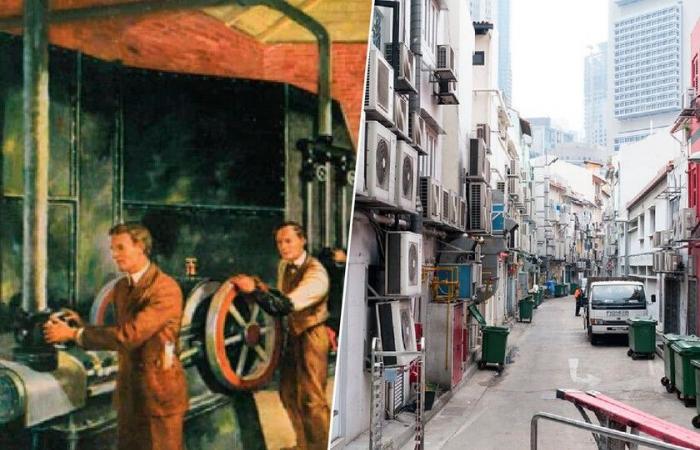
-
This is the story of one of the most famous creations of the 20th century and its surprising origin
-
One factor works in its favor: the planet does not stop warming
Air conditioning is both the angel and the devil of our society. While we can understand its use as a technology that has improved many lives, the explosive demand for energy in recent years due to climate change and rising temperatures poses environmental challenges. The curious thing about the invention is that it was not even created for us. The culprits were a printer and humidity.
The magazine and the printing press. As we will see, the concept of cooling air has been around for a long time (the ancient Egyptians hung water-soaked reeds from their windows and the Persians designed a kind of “cool-catching” chimney), but if we stick to the first air conditioner, then we have to go back to New York in 1902. There, a Brooklyn building (still standing) housed the Sackett-Wilhelms Lithographic and Publishing Company.
The problem? After two summers of extreme heat threatened the printing business, one of their clients, the illustrated humor magazine Judge, complained bitterly to Sackett & Wilhelms. Apparently, the paper used for printing absorbed so much moisture from the Brooklyn air that it expanded, and the colors used in the printing process did not align properly. In addition, the ink on the pages did not dry and they missed deadlines.
Carrier to the rescue. Enter Willis Haviland Carrier, a 25-year-old engineer who had just graduated and had been mulling over an idea for some time: getting rid of humidity as a way to cool the air. The key: drying the air by producing artificial fog. So his original plan was to force air through pipes filled with cold water drawn from a well between two buildings, a solution that included fans, ducts, heaters and perforated pipes.
Carrier created the machine in Buffalo and came up with a primitive cooling system to reduce the humidity around the printer by using an industrial fan to blow air over steam coils filled with cold water, the excess moisture would condense on the coils and produce cold air. He didn’t know it then, but he had just created the precursor to modern air conditioning.
The patent. After several years of struggle, on January 2, 1906, the engineer was granted US patent 808,897 for an “apparatus for treating air.” In 1913, Carrier developed the Carrier air humidifier designed to humidify the air in a single room. A milestone, as it was the first self-contained unit with the fan, motor, eliminator and aerosols combined in a single packaged product.
Carrier Engineering Corporation. The company was founded by the engineer together with seven colleagues. It occurs in New York on June 26, 1915. Since then, the company has gone through numerous mergers and acquisitions, becoming a subsidiary of United Technologies Corporation in 1980. Today it remains a world leader in commercial and residential refrigeration and air conditioning.
It gets better 20 years later. The truth is that the engineer’s original machine already performed the four basic tasks of an air conditioner: it controlled temperatures, humidity, air circulation and ventilation, and it cleaned the air. However, in 1922 a breakthrough occurred. Carrier itself develops the centrifugal refrigeration compressor: safer, smaller, faster and more powerful than the previous one.
In fact, one of the first practical centrifugal refrigeration compressors dating from that year is on display at the Smithsonian’s National Museum of American History, and the New York Stock Exchange building that acquired Carrier’s system became the first to be air-conditioned for human comfort alone.
Cinema and the postwar. The truth is that air conditioning was sweeping the industrial sector, but at an individual level it was another story, and here two key phenomena appear for its expansion to homes. First of all, the cinema. The films were the ones that managed to introduce the general public to the cold air in theaters. Then, in the middle of the 20th century, and in a scenario where people sought to “embrace” prosperity after the wars, air conditioning became a disruptive element.
Salvatore Basile, author of Cool: How Air Conditioning Changed Everything, recounted that “the 1950s were a time for keeping up with the Joneses.” Magazines like Life ran stories: “Air Conditioning/After War Will Be Cheap Enough to Install in Private Homes,” read the headlines. The technology was described as a prewar luxury that was manufactured in large quantities and sold at a modest cost in the postwar period.
First was the concept. But long before air conditioning was what it is today, the concept of cold air was already around. For example, Professor William Cullen of the University of Glasgow was already evaporating liquids in a vacuum, thus creating refrigeration technology in 1748. Later, John Gorrie, a doctor from Florida, used a small steam engine to cool the air for his patients. He called the invention “ice machine.”
If you’re wondering why Gorrie’s invention never caught on, we might have to point to the Northern ice makers who profited from shipping ice to the South, lobbying against Gorrie and gaining a public skeptical of the artificially cooled air produced by an ice machine. Indeed, the Smithsonian’s Peter Liebhold recalled that for a long time, efforts to control one’s environment also raised moral questions. “There was this idea that trying to control the environment was against God’s will,” Liebhold says.
The air conditioning today. The future looks complex, to say the least, for the original system created by Carrier. Although its use is widespread and skyrocketing in terms of electricity, improvements and efficiency are being sought. The Paris Olympics have already said that they want little AC, inventions that consume five times less are appearing and the use of more economical alternatives is even being promoted.
One very important factor plays in favor of AC: the planet does not seem to be cooling, but quite the opposite.
Image | Willis Carrier, Schezar, NMAH, PICRYL, Public Domain, SenseiAlan, PICRYL, PICRYL
At Xataka | The German invention that wants to put an end to air conditioning: a refrigerator with artificial “muscles”
In Xataka | An unusual solution to heat the house during the winter is becoming more and more advanced: sound waves





